Let me guess – bedtime at your house sounds like a negotiation with tiny terrorists? I’ve been there. My friend Sarah used to spend an hour every night trying to get her 4-year-old to stay in bed, until we discovered the magic of funny bedtime stories. Suddenly, her daughter was actually asking to go to bed early just to hear what silly thing would happen next.
Reading funny stories every day brings happiness to kids and helps them become better readers, according to SplashLearn research. I remember when my nephew refused to go to bed until we discovered “Don’t Let the Pigeon Drive the Bus!” – suddenly bedtime became the highlight of his day instead of a nightly battle. Finding that perfect balance between giggles and sleepiness isn’t always easy, but the right funny bedtime story can transform your evening routine from chaos to cherished bonding time.
Look, nobody wants to pick a book that gets your kid so wired they’re bouncing off the walls at 9 PM. Been there, done that, learned the hard way. You want stories that spark imagination while gently winding down the day’s excitement. The best funny bedtime stories create just enough engagement to hold attention while gradually preparing little minds for sleep.
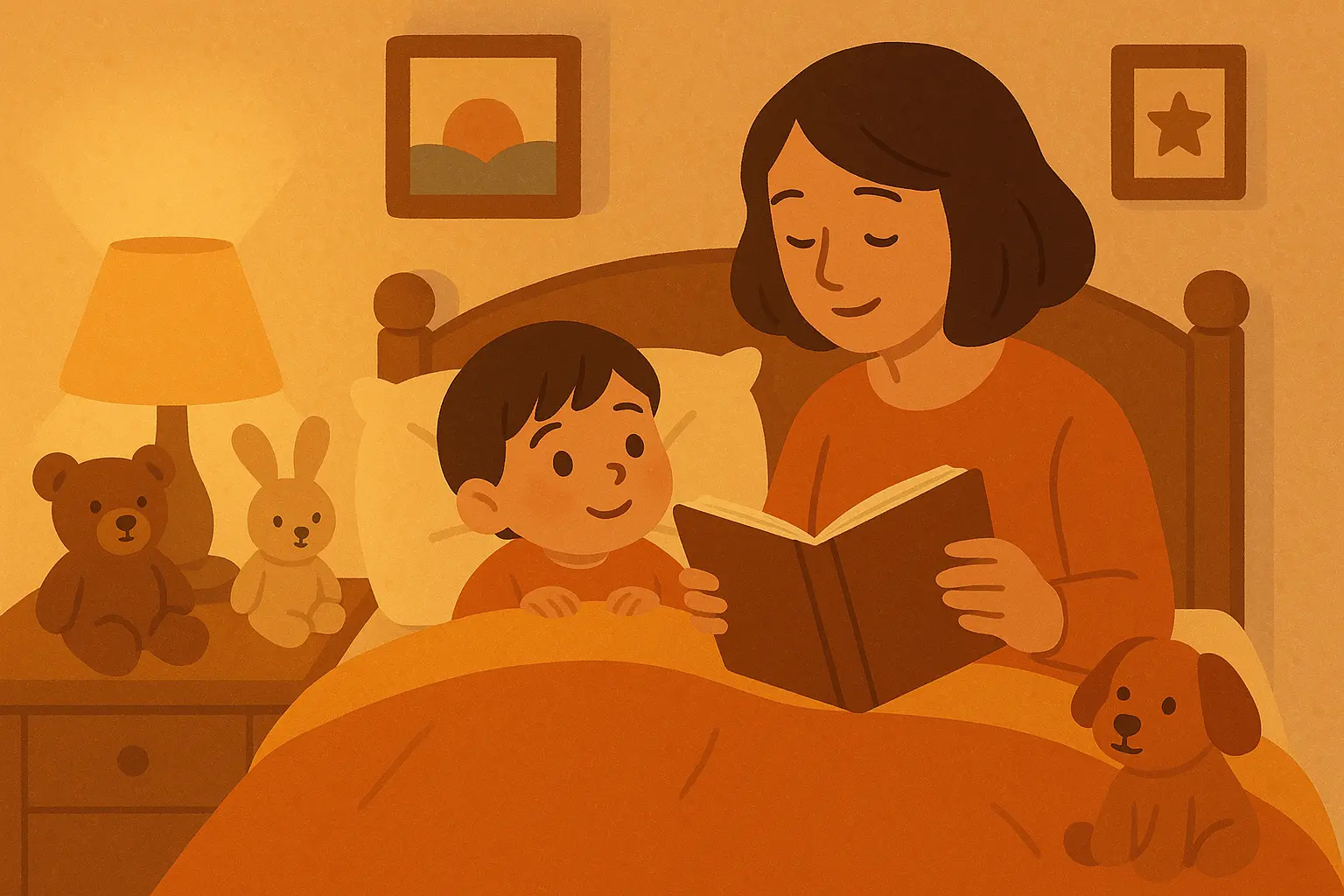
Table of Contents
-
What Actually Works at Bedtime (Trust Me on This)
-
Getting the Humor Right for Your Kid’s Age
-
Sleep-Friendly Content That Won’t Backfire
-
Balancing Giggles with Calm Energy
-
How Long Should These Stories Actually Be?
-
Interactive Elements That Don’t Turn Into Chaos
-
Keeping It Kind and Inclusive
-
-
25 Books That Never Fail (Tested by Real Parents)
-
Classic Picture Books That Work Every Time (Ages 2-6)
-
Silly Characters Your Kids Will Love (Ages 4-8)
-
Gentle Fantasy That Won’t Give Them Nightmares (Ages 5-10)
-
Family and Animal Stories That Feel Like Home (Ages 3-8)
-
Wordplay That Makes Everyone Laugh (Ages 4-10)
-
Interactive Stories That Actually Calm Them Down (Ages 2-7)
-
-
Why These Stories Are Parent Lifesavers
-
How Each Story Meets the “No Overstimulation” Test
-
What Makes Kids Laugh at Different Ages
-
Managing Energy Levels Like a Pro
-
-
Making Up Your Own Stories (It’s Easier Than You Think)
TL;DR
-
Different ages find completely different things funny – 3-year-olds crack up at silly sounds while 7-year-olds want clever wordplay and characters outsmarting adults
-
The best bedtime stories build to gentle endings, not exciting climaxes that leave kids wired and thinking instead of sleeping
-
Stories with repetitive patterns and soothing rhythms work way better than adventure tales for nighttime reading
-
Interactive elements should let kids participate without turning bedtime into a circus – think gentle call-and-response, not jumping around
-
Classic picture books, silly character adventures, and gentle fantasy consistently deliver giggles without the chaos
-
Keep it short for tired attention spans – 5-10 minutes for little ones, 15-20 minutes max for older kids
-
The goal isn’t perfection, it’s creating those sweet moments when they giggle into their pillow and drift off with a smile
What Actually Works at Bedtime (Trust Me on This)
Here’s what I’ve learned from years of bedtime battles and talking to other parents: not all funny stories are created equal when it comes to nighttime. Some will have your kids giggling softly and drifting off peacefully. Others will have them bouncing off the walls asking “What happens next?!” at 9:30 PM.
Getting the Humor Right for Your Kid’s Age
I used to think funny was funny, until I tried reading “Captain Underpants” to my 2-year-old and got blank stares, then read “Brown Bear, Brown Bear” to my 8-year-old and got an epic eye roll. Turns out, timing is everything.
Here’s what I’ve learned from years of bedtime battles: 3-year-olds will crack up at anything involving bodily functions or animals making weird noises. My nephew literally fell off his bed laughing when we read about a pig snorting. But try that same book with a 7-year-old? Eye roll city. They want clever wordplay and characters who outsmart the adults.
Understanding how different age groups respond to humor is similar to how effective bedtime stories must match developmental stages for maximum impact.
Toddlers (ages 2-4) are all about physical comedy – characters slipping on banana peels, making silly faces, or going “boo!” They also love simple sounds they can predict and join in with. Think “moo” and “oink” rather than sophisticated jokes they won’t get.
|
Age Group |
What Makes Them Laugh |
What Works at Bedtime |
What to Skip |
|---|---|---|---|
|
Toddlers (2-4) |
Physical comedy, silly sounds |
Characters falling, funny faces, “boo!” moments |
Complex wordplay, anything actually scary |
|
Preschoolers (4-6) |
Silly situations, gentle irony |
Characters making obvious mistakes, animals acting human |
Sarcasm they won’t understand, sophisticated jokes |
|
School-age (6-10) |
Wordplay, character-driven comedy |
Puns, clever problem-solving, social situations they recognize |
Adult humor, complex cultural references |
Preschoolers (ages 4-6) start getting more complex humor. They love when characters make obvious mistakes or when animals do human things like wearing clothes or driving cars. They’re also starting to understand gentle irony – like when a character says one thing but clearly means another.
School-age kids (ages 6-10) can handle sophisticated humor including puns, character-driven comedy, and situations that require understanding social dynamics. They appreciate stories where clever characters outsmart others or where everyday situations become absurd through exaggeration.
When my friend’s 3-year-old discovered “Llama Llama Red Pajama,” she would giggle at the dramatic rhyming (“Llama llama red pajama reads a story with his mama”) but then settle into the rhythm. However, when we tried reading the same book to her 7-year-old brother, he found it babyish and preferred “Captain Underpants” with its more sophisticated potty humor and character development.
The key is matching your story choice to where your kid is developmentally. A book that’s too young will bore them, too old will confuse them, but just right? That’s bedtime magic.
Sleep-Friendly Content That Won’t Backfire
I learned about the “energy arc” thing the hard way when I read my daughter an adventure story about pirates right before bed. She spent the next hour pretending her bed was a ship and her stuffed animals were her crew. Lesson learned: save the high-energy stuff for afternoon reading.
The humor in bedtime stories should energize imagination without overstimulating young minds. Stories that build to gentle, satisfying conclusions work much better than those with high-energy climaxes or cliffhanger endings that might keep kids thinking instead of sleeping.
Full disclosure: I once made the mistake of reading “Where the Wild Things Are” thinking it was funny. My daughter had nightmares for a week. Apparently, monsters aren’t hilarious when you’re 4 and it’s dark outside. Live and learn.
Warm, comforting humor beats exciting or scary comedy every time. Characters should face mild challenges that resolve through friendship, kindness, or simple problem-solving rather than through conflict or competition that might agitate children before sleep.
Stories with repetitive elements or soothing rhythms naturally lull children toward drowsiness. The predictable patterns become comforting, while the familiar structure helps anxious children feel secure as they prepare for sleep.
The best bedtime stories resolve conflicts through kindness and friendship while using soothing rhythms and predictable patterns to help children feel secure and ready for sleep, not amped up for more adventure.
Balancing Giggles with Calm Energy
Here’s why these stories are bedtime gold: they get your kid giggling without getting them hyped up. It’s like the difference between a gentle tickle fight and a full-on wrestling match. Both are fun, but only one ends with everyone calm enough for sleep.
The sweet spot for bedtime humor creates just enough engagement to hold attention while gradually reducing energy levels. You want children to giggle softly, not laugh so hard they become energized and alert.
Stories featuring funny characters doing everyday activities work better than high-adventure scenarios. A pig wanting buttered toast or a mouse asking for increasingly silly things maintains interest without creating excitement that interferes with sleep preparation.
The best funny bedtime stories follow an energy arc that starts with mild engagement, builds to gentle humor, then winds down to peaceful resolution. This mirrors the natural progression from awake to drowsy to asleep.
Think of it like a gentle roller coaster rather than a rocket ship – some ups and downs, but nothing that launches your kid into orbit when they should be settling down.
How Long Should These Stories Actually Be?
Let’s be real about attention spans here. When your kid is tired and you’re exhausted after a long day, nobody wants a novel. Bedtime stories must match tired attention spans without feeling rushed or incomplete.
Younger children (ages 2-5) typically handle 5-10 minute reads best, while older children (ages 6-10) can manage 15-20 minute stories when they’re genuinely engaged.
|
Age Group |
Sweet Spot Length |
Page Count |
What to Look For |
What to Avoid |
|---|---|---|---|---|
|
2-3 years |
3-5 minutes |
10-20 pages |
Simple, familiar words |
Long, complex sentences |
|
4-5 years |
5-10 minutes |
20-32 pages |
Basic vocabulary with some new words |
Confusing plot twists |
|
6-8 years |
10-15 minutes |
32-48 pages |
Expanded vocabulary |
Adult themes |
|
9-10 years |
15-20 minutes |
48+ pages |
Complex vocabulary |
Cliffhangers that keep them thinking |
Language complexity matters enormously when parents are tired too. Stories with accessible vocabulary and smooth sentence flow prevent stumbling over difficult passages that might break the bedtime mood or frustrate exhausted caregivers.
The best funny bedtime books can be shortened naturally if children are particularly tired, with clear stopping points that still provide satisfying conclusions. This flexibility helps maintain consistent bedtime routines even when schedules vary.
Pro tip: Look for books where you can skip a page or two if needed without losing the story thread. Sometimes you just need to get to “The End” faster, and that’s totally okay.
Interactive Elements That Don’t Turn Into Chaos
The best interactive books let your kid participate without turning into a one-person circus. Like in “Brown Bear,” they can chant along, but they’re not jumping around the room pretending to be animals. Save that energy for daytime, trust me.
Stories that invite gentle participation enhance engagement without requiring energetic responses. Sound effects, repeated phrases, or simple questions work well when they don’t demand physical activity or complex thinking from drowsy children.
The best interactive elements become predictable parts of the bedtime story that children can anticipate and join without becoming alert or excited. Repeated refrains or familiar sound patterns create participation opportunities that feel soothing rather than stimulating.
Avoid stories requiring too much audience response or complex memory work. Simple call-and-response patterns or opportunities to “help” predict what happens next work much better than elaborate participation requirements.
Think whisper-level participation, not performance-level energy. Your goal is engagement, not entertainment that requires an encore.
Keeping It Kind and Inclusive
Look, we want our kids to see all kinds of families and backgrounds in their books, but we also don’t want bedtime stories that make anyone feel left out or weird. Stick to books where the humor comes from silly situations, not making fun of how people look or talk.
Funny bedtime stories should reflect positive values and inclusive perspectives that welcome all children. Humor should never come at the expense of differences or promote negative stereotypes that might make some children feel excluded or uncomfortable.
The best children’s humor celebrates diversity and teaches kindness through laughter. Stories that show different types of families, various cultural backgrounds, and characters with different abilities help all children see themselves represented in positive ways.
Choose stories where the humor comes from situations, wordplay, or gentle character quirks rather than making fun of how people look, speak, or live. This ensures bedtime remains a positive, welcoming experience for every child.
Besides, the funniest stories are usually about universal experiences – like being stubborn, making mistakes, or wanting something you can’t have. Every kid can relate to that, regardless of background.
25 Books That Never Fail (Tested by Real Parents)
Okay, let’s get to the good stuff. These 25 books have been battle-tested by exhausted parents everywhere. I’ve organized them by category so you can find exactly what works for your kid’s age and personality.
These bedtime stories for kids have been tested by countless families and consistently deliver the perfect balance of giggles and calm energy needed for successful nighttime routines.
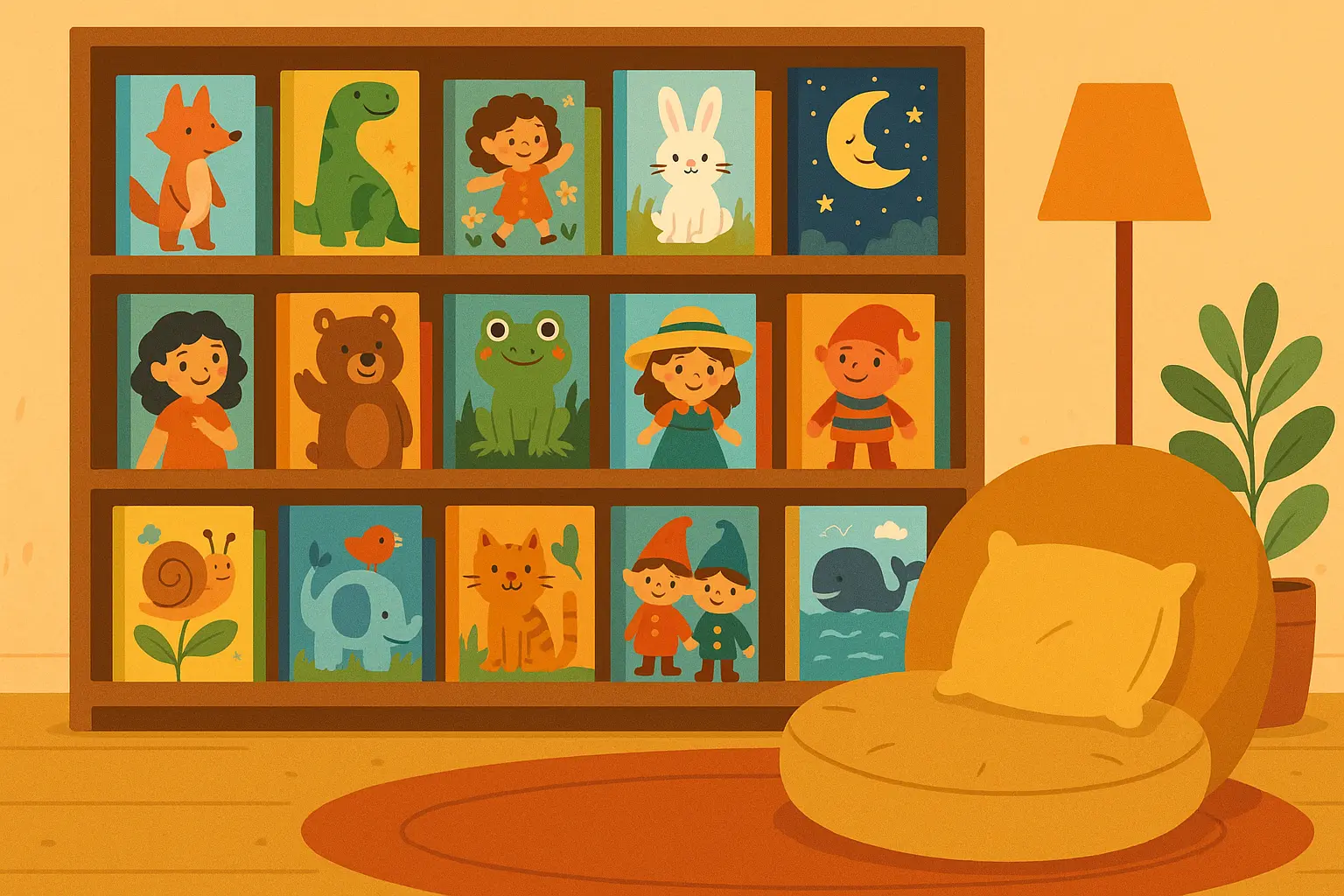
Classic Picture Books That Work Every Time (Ages 2-6)
These are the heavy hitters – the books that have been making kids giggle at bedtime for decades. There’s a reason they’re classics: they just work.
1. “Don’t Let the Pigeon Drive the Bus!” by Mo Willems
Okay, can we talk about this book for a second? This pigeon is basically every toddler ever. “Please? Pretty please? I’ll be your best friend!” Sound familiar? My kids love getting to be the authority figure for once, and I love watching that pigeon’s meltdown because honestly, it’s exactly what my 3-year-old does when I say no to ice cream for breakfast.
The interactive element of readers saying “NO!” gives children power in the story while the pigeon’s eventual acceptance provides the closure needed for bedtime. The humor comes from the pigeon’s ridiculous arguments progressing from reasonable to absurd.
2. “The Book with No Pictures” by B.J. Novak
This book is pure genius and also slightly evil because it forces you to say ridiculous things like “My head is made of blueberry pizza!” But here’s the thing – your kids will be in absolute stitches, and you’ll find yourself laughing too at how silly you sound.
The book’s genius lies in making the reading process itself the entertainment. Children control the experience simply by listening, while parents become the source of silliness through the book’s clever text manipulation.
3. “Dragons Love Tacos” by Adam Rubin
Dragons having a taco party? Yes, please. The premise is wonderfully absurd, and the cause-and-effect logic (dragons + spicy salsa = house destruction) is exactly the kind of reasoning preschoolers can follow and find hilarious.
The domestic setting (a backyard party) keeps the fantasy grounded and non-threatening, while the detailed illustrations create endless re-reading opportunities as children discover new visual jokes.
4. “The Day the Crayons Quit” by Drew Daywalt
Each crayon writes a resignation letter with hilarious complaints about their working conditions – Red is overworked from coloring fire trucks and hearts, while Beige feels ignored and underappreciated. It’s like “The Office” for preschoolers.
Plus, if your kid is extra tired, you can literally stop after any crayon’s letter and they’ll still feel like they got a complete story. And honestly? The ending where all the crayons make up always makes me a little teary-eyed too.
5. “Llama Llama Red Pajama” by Anna Dewdney
Pro tip: “Llama Llama Red Pajama” is perfect for kids who get anxious when you leave the room. After reading this, you can say “Remember what Mama Llama told Baby Llama?” and it actually works sometimes.
The story validates children’s bedtime fears while showing patient parental response, making it both funny and reassuring for children who experience similar nighttime anxieties. The rhythm and rhyme create a soothing reading experience despite the character’s distress.
These classic picture books master the balance between entertainment and bedtime calm through simple concepts, engaging illustrations, and age-appropriate comedy. They use interactive elements, absurd premises, and validation of childhood experiences while maintaining the gentle energy levels perfect for sleep preparation.
Silly Characters Your Kids Will Love (Ages 4-8)
These books feature characters with such distinct personalities that kids ask for them by name. “Can we read the one about the pig who loves buttered toast?” Yep, that’s Mercy Watson

6. “Captain Underpants” series by Dav Pilkey
Look, I know what you’re thinking – underwear jokes at bedtime? But hear me out. Despite the superhero premise, these stories actually end with everything returning to normal at school, which provides the stability kids need for bedtime reading. Plus, any book that makes reading feel rebellious is a win in my book.
The potty humor and comic book format appeal to elementary-aged kids who enjoy the subversion of authority figures they recognize, while the humor comes from contrasting the principal’s dignified day job with his underwear-clad alter ego.
7. “Amelia Bedelia” series by Peggy Parish
This literal-minded housekeeper is comedy gold. When told to “draw the drapes,” she literally draws pictures of curtains. My 5-year-old thinks this is the height of humor, and honestly, the wordplay is pretty clever even for adults.
The episodic adventures always resolve with Amelia’s employers recognizing her good intentions despite the chaos, creating warm endings that emphasize understanding and forgiveness.
8. “Frog and Toad” series by Arnold Lobel
These two friends are relationship goals, honestly. Frog’s patience with Toad’s anxieties is something we could all learn from. Even when they face challenges or misunderstandings, they support each other and find peaceful solutions through their friendship.
The gentle comedy and emotional warmth make these perfect for winding down, while the friendship theme models emotional regulation and conflict resolution for children.
9. “Mercy Watson” series by Kate DiCamillo
A pig with simple desires (buttered toast, car rides) who creates domestic chaos in her loving household – what’s not to love? The humor comes from the gap between Mercy’s pig nature and her family’s treatment of her as a beloved pet.
The episodic adventures focus on Mercy’s single-minded pursuits leading to unexpected but harmless consequences, while the warm illustrations and gentle resolutions provide comfort alongside giggles.
10. “Elephant and Piggie” series by Mo Willems
One parent shared how her anxious 6-year-old connected deeply with Gerald the Elephant’s worries in this series. When Gerald frets about whether Piggie will like his gift, her son would nod knowingly and say, “He thinks like me!” The gentle resolution where friendship conquers worry became a bedtime ritual that helped her son process his own daily anxieties.
The conflicts are always resolved through friendship and understanding, with the physical comedy remaining visual rather than action-packed, making these perfect for maintaining bedtime calm.
These silly character adventures focus on memorable personalities whose quirks drive gentle humor through everyday situations. The characters’ relationships, misunderstandings, and unique approaches to simple problems create comedy that emphasizes friendship, understanding, and peaceful resolution.
Gentle Fantasy That Won’t Give Them Nightmares (Ages 5-10)
Fantasy can be tricky at bedtime because you want magic without monsters under the bed later. These books nail that balance perfectly.
11. “The Enormous Crocodile” by Roald Dahl
The crocodile’s plans are obviously doomed from the start, which lets kids enjoy the suspense while feeling completely safe. Plus, Dahl’s trademark wit is gentler here than in some of his other books, making it perfect for bedtime.
The jungle animals’ teamwork provides positive messaging about community protection, while the crocodile’s elaborate plans to eat children are consistently foiled by clever animals who see through his disguises.
12. “Room on the Broom” by Julia Donaldson
This rhyming story about a kind witch picking up animal friends is pure comfort. Each new animal friend creates more chaos but also more help when trouble arrives, teaching lessons about friendship and cooperation.
The rhyming text and cumulative structure create a soothing, predictable pattern, while the magical elements remain whimsical rather than scary.
13. “The Gruffalo” by Julia Donaldson
The twist ending where the scary Gruffalo is actually afraid of the mouse deflates any scary energy into giggles. The repetitive structure becomes comforting as children anticipate the pattern, while the mouse’s safe return home provides complete emotional resolution.
A clever mouse invents a scary creature to frighten predators, only to meet the real Gruffalo and discover he’s afraid of the mouse, teaching about courage and cleverness.
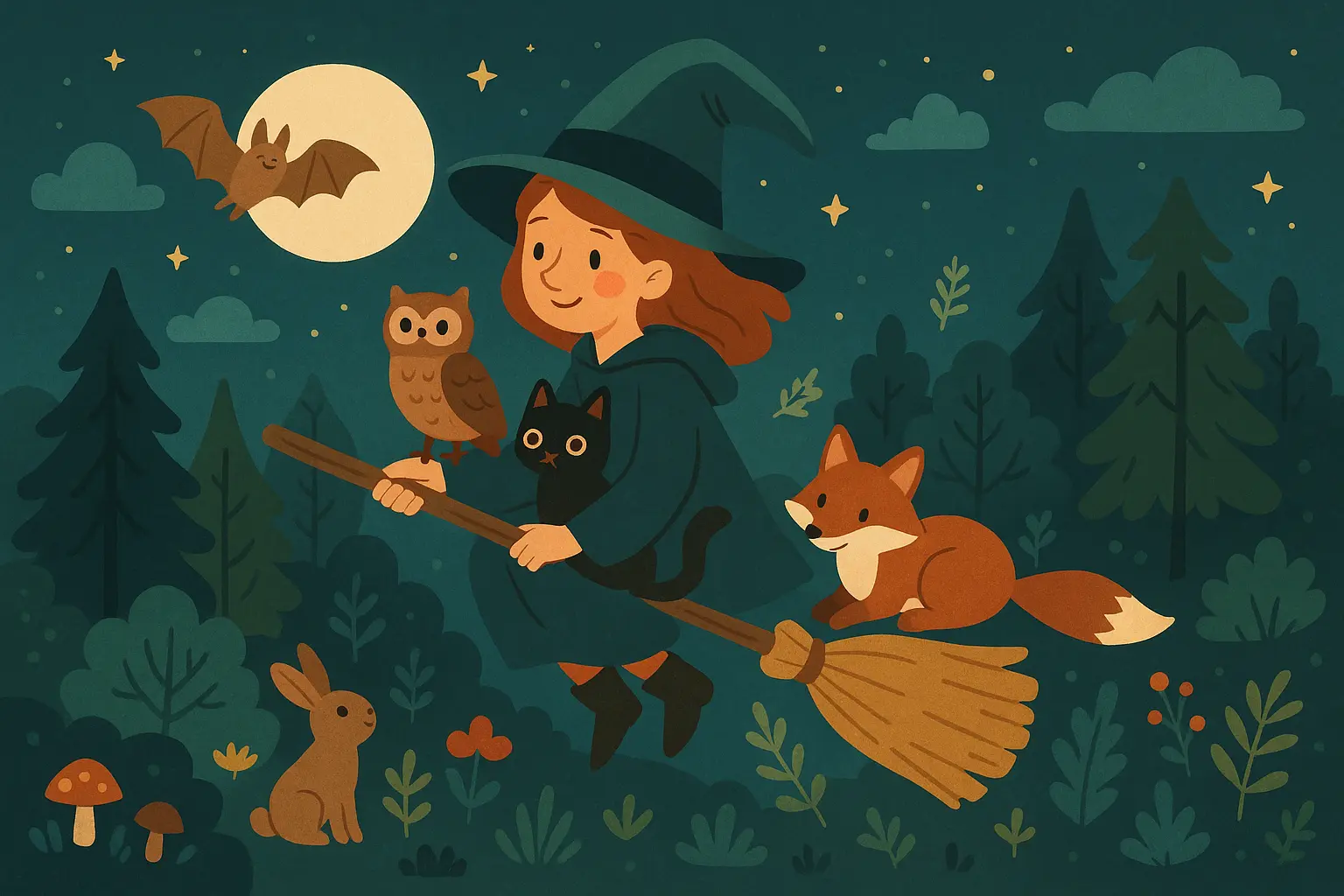
14. “Where’s My Teddy?” by Jez Alborough
A boy searching for his lost teddy bear in dark woods encounters a giant bear looking for his tiny teddy. The size mix-up creates gentle humor while addressing the universal childhood experience of losing a beloved toy.
The mutual fear and eventual understanding between boy and bear resolves sweetly, with both characters reunited with their appropriate-sized teddy bears in a satisfying, peaceful conclusion.
15. “The Witch’s Cat and the Cooking Catastrophe” by Lynne Reid Banks
The domestic setting keeps the fantasy grounded and cozy while the magical mishaps remain harmless and funny. The story focuses on good intentions gone wrong rather than conflict.
A witch’s cat tries to help with dinner preparations but creates magical mayhem in the kitchen instead, with the resolution emphasizing teamwork and understanding between the witch and her well-meaning cat.
These gentle fantasy stories combine magical elements with cozy, non-threatening situations. They feature clever characters, repetitive patterns, and whimsical magical elements that remain comforting rather than exciting, with resolutions that emphasize friendship, cleverness, and peaceful endings.
Family and Animal Stories That Feel Like Home (Ages 3-8)
These books feel like peeking into someone’s loving, slightly chaotic household – which is exactly what makes them so comforting at bedtime.
16. “If You Give a Mouse a Cookie” by Laura Joiner Numeroff
This circular tale is brilliant because kids can predict what’s coming next, but they still find it hilarious every time. The mouse’s increasingly silly demands create predictable humor that children love anticipating.
The domestic setting keeps everything non-threatening while the circular structure provides complete satisfaction without cliffhangers, making it perfect for bedtime closure.
17. “Olivia” series by Ian Falconer
Despite Olivia’s spirited personality, these stories follow a calming bedtime rhythm that ends with exhausted collapse – which honestly mirrors most parents’ days too. The humor comes from the gap between Olivia’s grand self-perception and her small pig reality.
A precocious pig navigates daily life with dramatic flair and boundless energy, but each book follows her through a day that naturally winds down to sleep.
18. “Chrysanthemum” by Kevin Henkes
This story addresses name-calling sensitively while maintaining warmth. A mouse loves her unique name until school classmates tease her about it, but the gentle humor comes from the mouse family’s loving support.
The eventual resolution when the music teacher reveals her own floral name teaches acceptance through understanding rather than confrontation.
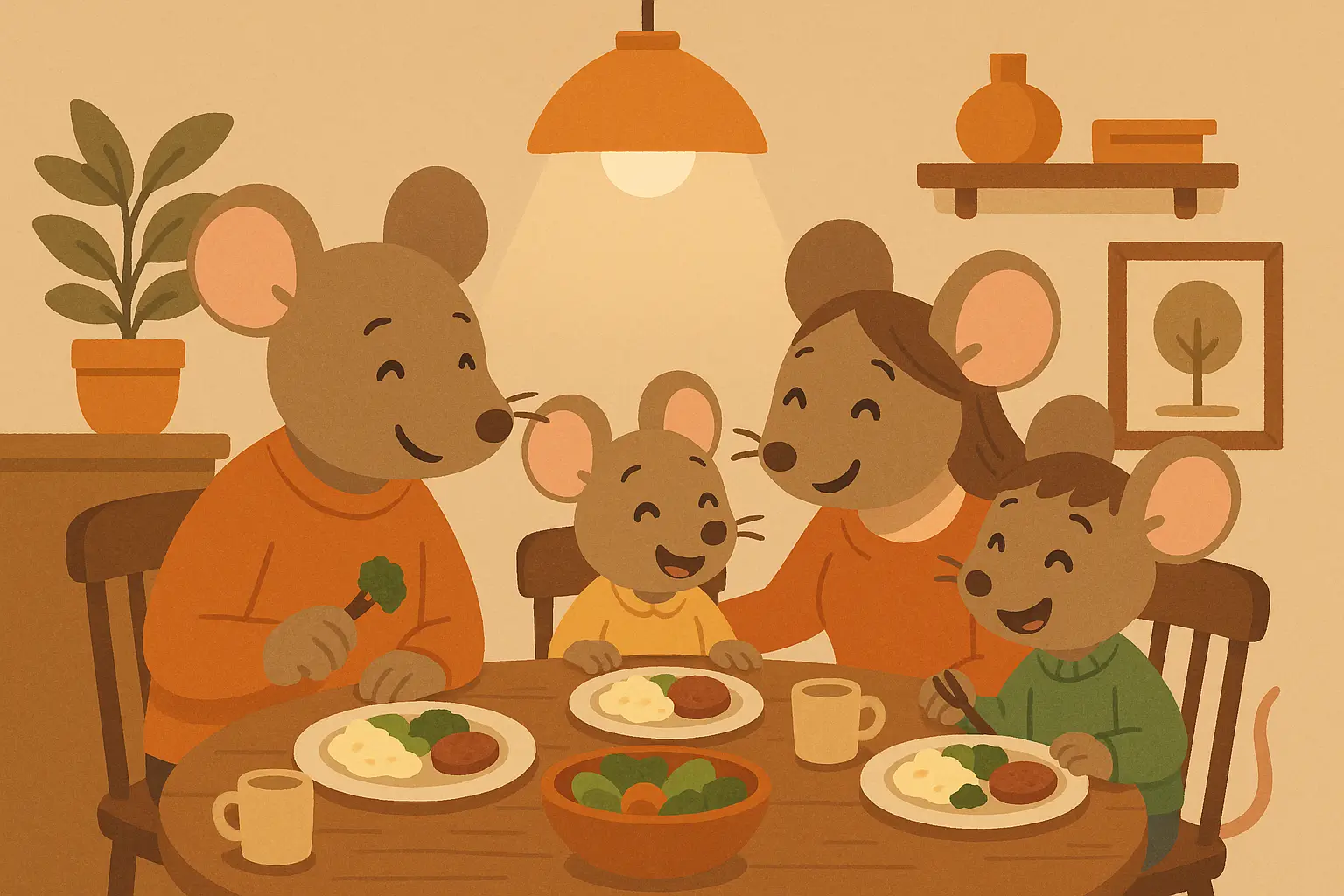
19. “Officer Buckle and Gloria” by Peggy Rathmann
The physical comedy comes from Gloria’s secret performances that make the safety tips memorable. A safety officer discovers his dog partner is the real star of their school presentations through her behind-the-scenes antics.
The friendship theme and recognition that everyone contributes differently provides positive messaging while the workplace humor appeals to children who understand school dynamics.
20. “Click, Clack, Moo: Cows That Type” by Doreen Cronin
The absurd premise of literate livestock negotiating for electric blankets creates sophisticated humor children can understand. Farm animals discover a typewriter and begin making demands of Farmer Brown through typed notes.
The workplace satire translates perfectly to barnyard setting while the duck serving as “neutral party” adds layers of comedy alongside conflict resolution lessons.
These family and animal stories focus on domestic situations and relatable characters navigating everyday challenges with humor. They feature loving family dynamics, workplace comedy adapted for children, and animal characters whose human-like behaviors create gentle absurdity while teaching lessons about acceptance, friendship, and cooperation.
Wordplay That Makes Everyone Laugh (Ages 4-10)
These books turn language into a playground, and honestly, they’re as much fun for adults to read as they are for kids to hear.
The language-focused approach in these stories demonstrates how effective storytelling can engage multiple learning pathways while entertaining children.
21. “Chicka Chicka Boom Boom” by Bill Martin Jr.
The “boom boom” creates anticipation and release that children find irresistible. Letters of the alphabet race up a coconut tree in this rhythmic, rhyming adventure that ends with a satisfying crash.
The musical language mimics children’s natural speech patterns while giving each letter distinct personality, and the tree climbing makes alphabet learning physical and memorable without requiring actual movement.
22. “There Was an Old Lady Who Swallowed a Fly” (various versions)
Kids love the cumulative aspect because they can show off by remembering the growing list. The cumulative song about increasingly large animals being swallowed provides predictable humor and audience participation.
The absurdity peaks with swallowing a horse (“She’s dead, of course!”), providing definitive closure that satisfies rather than disturbs through its obvious impossibility.
23. “Green Eggs and Ham” by Dr. Seuss
Sam-I-Am’s persistent offers teach about trying new things through limited vocabulary and repetitive structure. The 50-word vocabulary makes reading smooth while children can predict and participate.
The circular journey from rejection to acceptance provides satisfying character growth while the rhyming text creates a lullaby-like quality perfect for bedtime stories.
24. “The Cat in the Hat” by Dr. Seuss
The return to order before mother comes home provides the stability children need, while the cat’s antics remain contained within the house setting. A mischievous cat brings controlled chaos to two children’s boring day.
The rhyming text and predictable meter create soothing rhythm despite the story’s energy, with escalating mayhem followed by complete cleanup.
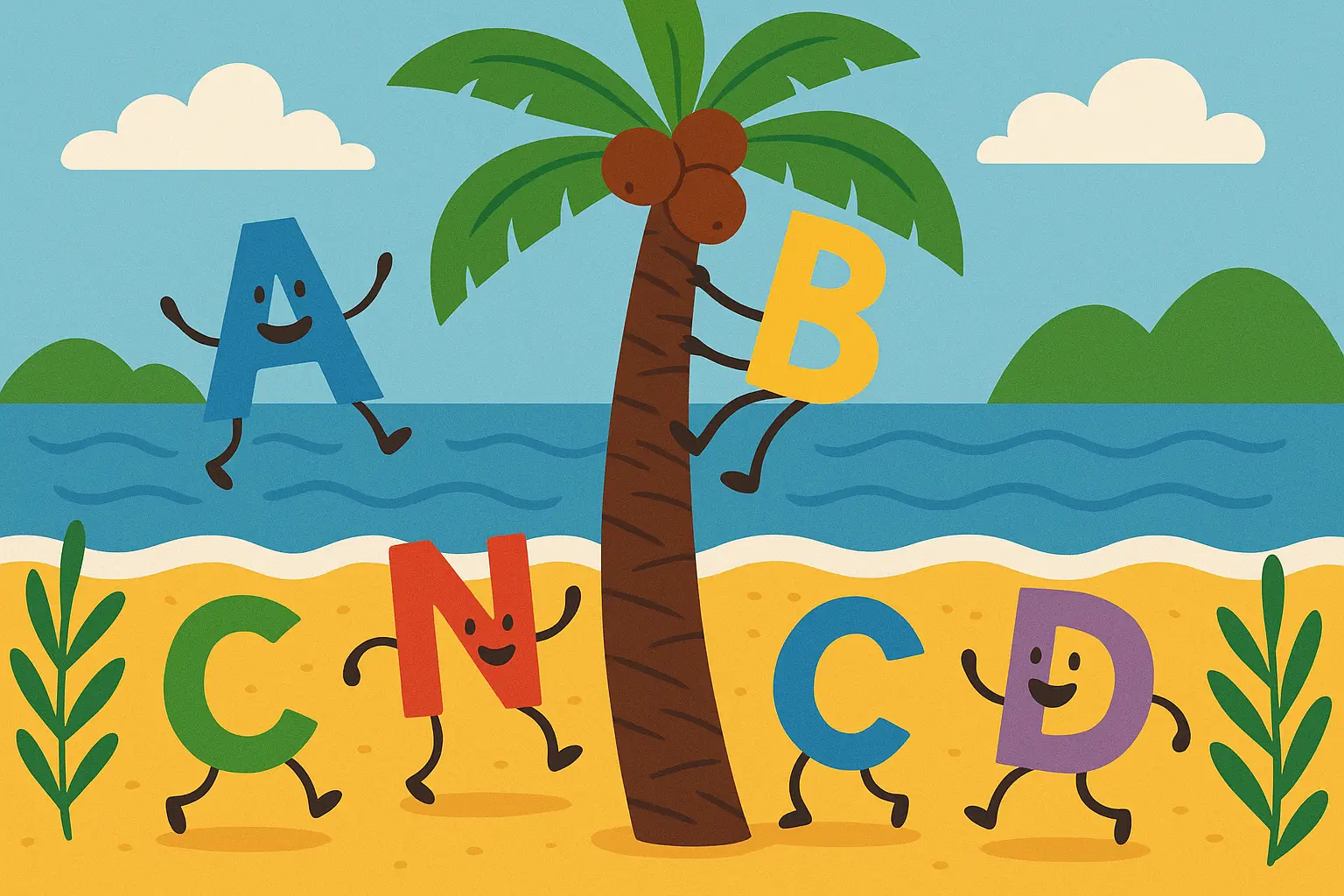
These wordplay stories use rhymes, repetition, and creative vocabulary to build phonetic awareness while entertaining children. They demonstrate how limited vocabulary, musical language patterns, and predictable structures can create both educational value and bedtime-appropriate humor.
Interactive Stories That Actually Calm Them Down (Ages 2-7)
The magic of these books is that kids feel like they’re part of the story without needing to bounce around the room.
25. “Brown Bear, Brown Bear, What Do You See?” by Bill Martin Jr.
Children naturally join in asking “What do you see?” while the circular ending brings satisfying closure. A call-and-response story featuring colorful animals invites children to predict and participate in the familiar pattern.
The repetitive structure becomes comforting while the bright illustrations maintain visual interest, making even very young children feel like successful “readers.”
These interactive stories engage children through predictable patterns and gentle audience involvement that doesn’t require energetic responses. They use call-and-response formats, repetitive structures, and familiar patterns that allow children to participate successfully while maintaining calm energy.
Why These Stories Are Parent Lifesavers
Here’s the thing about these 25 books – they’re not just entertaining, they’re strategically designed (whether intentionally or not) to work with your child’s natural bedtime needs rather than against them.
How Each Story Meets the “No Overstimulation” Test
The worst bedtime stories are the ones that end with cliffhangers or big exciting finales. I learned this when I read a book that ended with “What adventure will they have tomorrow?” My son spent 45 minutes planning imaginary adventures instead of sleeping. Never again.
The most successful funny bedtime stories share common characteristics that make them perfect for nighttime reading. They build engagement without creating excitement, resolve conflicts through kindness rather than confrontation, and end with emotional satisfaction rather than cliffhangers.
|
Story Element |
Sleep-Friendly Version |
Overstimulating Version |
|---|---|---|
|
Conflict Resolution |
Characters solve problems through friendship |
Heroes defeat villains through battles |
|
Energy Arc |
Gentle build-up to peaceful conclusion |
High-energy climax with exciting ending |
|
Setting |
Familiar, domestic environments |
Exotic, adventure-filled locations |
|
Character Actions |
Everyday activities with humorous twists |
Dangerous quests or competitive challenges |
|
Emotional Tone |
Warm, comforting, reassuring |
Thrilling, suspenseful, intense |
Stories featuring domestic settings and everyday activities feel safer and more comforting than adventure tales. Characters dealing with familiar situations (bedtime fears, friendship challenges, family dynamics) help children process their own experiences while winding down.
The best bedtime story follows predictable patterns that become soothing through repetition. Whether it’s the circular structure of “If You Give a Mouse a Cookie” or the call-and-response pattern of “Brown Bear, Brown Bear,” familiar formats help anxious children feel secure.
What Makes Kids Laugh at Different Ages
A kindergarten teacher noticed that during story time, her 5-year-olds would burst into giggles when Amelia Bedelia “dressed the chicken” by putting clothes on it, understanding the literal interpretation was silly. However, when she read the same story to 3-year-olds, they were confused rather than amused, not yet grasping the wordplay that made it funny.
Toddlers respond best to physical comedy and simple cause-and-effect humor they can understand immediately. Stories where characters slip, fall, or make silly faces provide instant gratification without requiring complex thinking that might keep young minds active.
Preschoolers appreciate situational humor and gentle irony they can grasp. They enjoy bedtime stories where characters make obvious mistakes or misunderstand simple instructions, finding humor in the gap between intention and result.
School-age children can handle more sophisticated wordplay, character development, and social situations. They appreciate stories where clever characters solve problems or where everyday situations become absurd through exaggeration or unexpected twists.

Understanding your kid’s developmental stage helps you pick books that will actually land. A story that’s too young will get eye rolls, too old will get blank stares, but just right? That’s when the magic happens.
Managing Energy Levels Like a Pro
The best funny bedtime stories use specific techniques to manage children’s energy levels throughout the reading experience. They start with mild engagement, build to gentle humor peaks, then wind down to peaceful resolution that mirrors the natural sleep transition.
Repetitive elements and soothing rhythms naturally lull children toward drowsiness while maintaining just enough interest to prevent restlessness. The predictable patterns become comforting rather than boring through skilled execution.
Circular story structures provide complete satisfaction without loose ends that might keep children thinking after the book closes. Stories that end where they began or return to peaceful starting points give children permission to let go and drift toward sleep.
It’s like conducting a gentle orchestra where every element works together to create the perfect bedtime symphony – engaging enough to hold attention, soothing enough to prepare for sleep.
Making Up Your Own Stories (It’s Easier Than You Think)
Creating your own stories sounds intimidating, but it’s honestly easier than you think. Start with your kid’s stuffed animals having a boring day – like Teddy trying to decide what to have for lunch. Add one silly thing (maybe all the food keeps falling off his spoon), and boom – you’ve got a story that’s perfectly tailored to your kid’s sense of humor.
Sometimes you need fresh material that speaks directly to your child’s current interests, fears, or developmental stage. Creating personalized bedtime stories for kids allows you to incorporate familiar characters, address specific situations, and maintain the perfect energy balance for your individual child’s needs.
Start with simple premises involving everyday activities your child recognizes. A story about their stuffed animals having a tea party or their pet’s secret adventures while the family sleeps provides familiar ground for gentle humor. Use repetitive phrases or predictable patterns that your child can anticipate and join. This participation creates engagement while the familiar structure provides the security needed for bedtime calm.
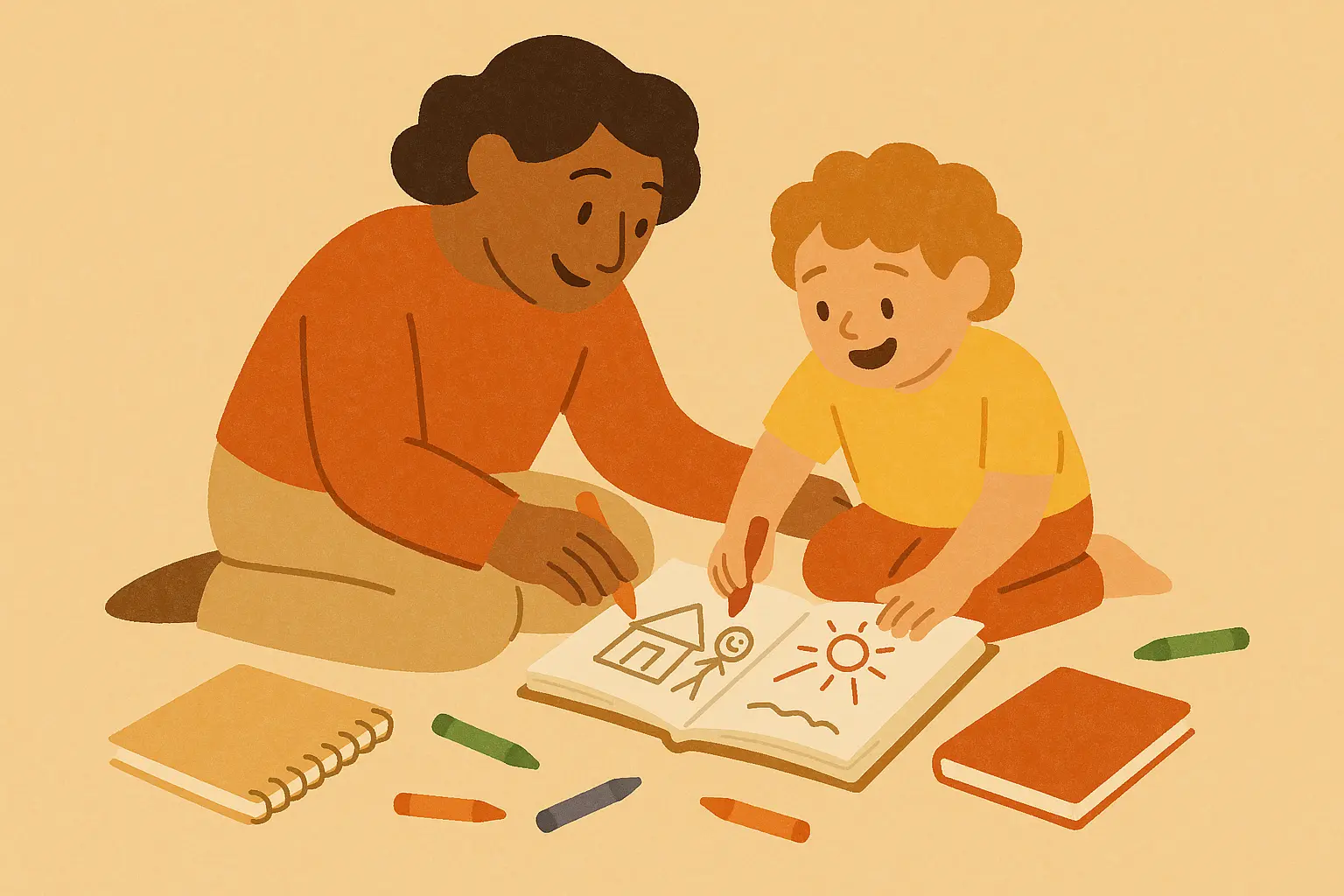
This is where Nairrate’s Story Starters Generator becomes invaluable for busy parents and caregivers. Instead of struggling to create original content after exhausting days, you can generate personalized funny bedtime stories for kids that incorporate your child’s favorite characters, interests, and current developmental needs.
Nairrate’s AI understands the delicate balance required for bedtime stories – creating engagement without overstimulation, incorporating age-appropriate humor, and building to satisfying conclusions that prepare children for sleep. Whether you need a story about a brave teddy bear for an anxious child or a silly adventure featuring your family pet, the platform can generate content that feels personally crafted while meeting all the criteria for effective bedtime reading.
For parents who want to explore different storytelling approaches, Nairrate’s bedtime story generator offers additional customization options that ensure your stories maintain the perfect balance between humor and sleep-friendly content.
You can also draw inspiration from effective short story techniques to craft narratives that engage children while following proven patterns for bedtime success.
The beauty of making up your own stories is that you can tailor them exactly to what your kid needs that night. Had a rough day at school? Create a story about a character who makes mistakes but learns that everyone messes up sometimes. Worried about starting at a new daycare? Tell them about a shy bunny who discovers the new playground has the best slide ever.
Creating personalized funny bedtime stories allows parents to address specific interests and needs while maintaining sleep-friendly characteristics. Whether you craft them yourself or use tools like Nairrate’s generators, custom content can incorporate familiar elements, age-appropriate humor, and proper energy management without requiring hours of creative work.
Final Thoughts
Listen, some nights even the perfect bedtime story won’t work. Your kid will still pop up asking for water, claiming they heard a scary noise, or suddenly remembering they need to tell you about something that happened at school three weeks ago. That’s parenthood. But on the nights when everything clicks – when they’re giggling softly and drifting off with a smile – you’ll remember why this bedtime story thing is totally worth it.
The 25 stories I’ve shared here represent years of testing by parents, librarians, and children themselves – each one proven to deliver giggles while gently preparing young minds for sleep. These aren’t just books; they’re tools for transforming potentially chaotic bedtime routines into cherished bonding experiences.
Remember that the best bedtime story is one that works for your specific child at their current developmental stage. Some children need the predictable comfort of familiar favorites, while others crave variety and surprise. Pay attention to what makes your child giggle softly versus what energizes them, and adjust your selections accordingly.
The goal isn’t perfection – it’s creating those sweet moments when they giggle into their pillow and drift off with a smile. These carefully chosen funny bedtime stories provide that perfect balance, creating memories that will last long after your children have outgrown bedtime stories altogether.
And hey, if all else fails, there’s always “just five more minutes” of snuggling. Sometimes that’s the best story of all.



Add comment